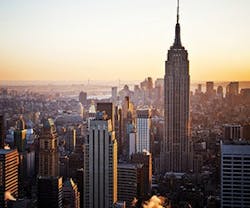How NYC High-Rises Can Battle Heat Loss
New York City apartment buildings could save $110 million in just 10 years with some simple retrofits aimed at preventing heat loss through elevator shaft vents, according to a recent study by the Urban Green Council.
Owners of apartment buildings spend an average of $3,400 per year to heat air that rises to the roof and escapes from open shaft vents, which were originally intended to promote fire safety by drawing smoke out of the building through the roof. Buildings at least 10 stories tall are most vulnerable to energy waste due to this phenomenon, with taller buildings spending more than $20,000 annually to compensate for the heat loss.
“Elevator vents alone will leak about a living room’s worth of warm air every minute,” notes the study. “All the air that escapes through open vents is replaced with cold air from outside, which then needs to be warmed by the building’s heating system. That means that 4 to 16% of heating fuel is being used to heat the outdoors, most of which can be saved by fixing these holes.”
Until recently, city code only allowed owners to partially cover the vents, even though changes in building construction and firefighting strategy no longer require the vents to stay open year-round. However, a 2014 change allows affordable new solutions costing as little as $500 per building . The solution, quite simply, is to plug the holes.
Two main options exist for retrofits, the Urban Green Council explains. Smaller, simpler buildings can cover two-thirds of the vents with annealed glass and leave the rest open, which will cost roughly $500 to $2,000 and can be installed in-house. Paybacks of less than a year are likely.
Larger, more complex buildings can instead opt for motorized louvers that will cover the entire vent area, but open whenever the alarm system or a smoke detector goes off. Electricity for the louvers and access to the fire system are required, so building owners must bring in an engineer to ensure code compliance. This solution will cost $5,000 to $15,000, the Urban Green Council says, but paybacks of one to five years are still likely.
The organization also recommends conducting an energy audit at the same time to find additional leakage around windows, doors, and equipment.
“Other added benefits include more uniform indoor temperatures and increased building resiliency during extreme weather,” the council adds. “The audit can find many other areas where fuel and electricity use can be lowered cost-effectively.”
The full study includes worksheets on estimating your building’s potential energy savings. To see how much you could conserve, read Spending through the Roof at urbangreencouncil.org.
